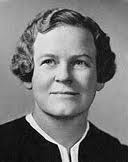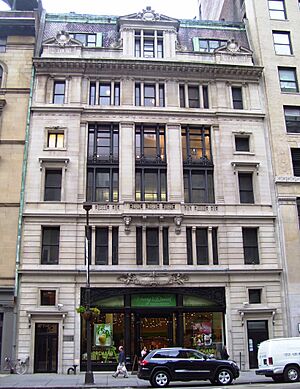Alice Dalgliesh facts for kids
Quick facts for kids
Alice Dalgliesh
|
|
|---|---|
 |
|
| Born | Alice Dalgliesh October 7, 1893 Trinidad, British West Indies |
| Died | June 11, 1979 Woodbury, Connecticut, United States |
| Occupation | Writer, publisher |
| Citizenship | American (naturalized) |
| Notable works |
|
| Notable awards | Newbery Medal runner-up 1945, 1953, 1955 |
Alice Dalgliesh (born October 7, 1893 – died June 11, 1979) was an American author and publisher. She wrote over 40 books, mostly for children, including both fiction and non-fiction. Many people consider her a "pioneer" in writing historical stories for kids. Three of her books were honored with the annual Newbery Medal: The Silver Pencil, The Bears on Hemlock Mountain, and The Courage of Sarah Noble. The Courage of Sarah Noble also won the Lewis Carroll Shelf Award.
Alice Dalgliesh was also very important in the world of children's books as the first editor of the Children's Book Division at Scribner's and Sons (starting in 1934). She helped publish books by many famous authors and illustrators, like Robert A. Heinlein, Marcia Brown, and Marjorie Kinnan Rawlings. Because of her important role, she became the first president of the Children's Book Council, which is a group for children's book publishers.
Contents
Biography
Alice Dalgliesh was born on October 7, 1893, in Trinidad, which was then part of the British West Indies. When she was 13, her family moved to England. Six years later, she came to America to study how to teach young children at the Pratt Institute in New York City.
She later earned degrees in Education and English Literature from Columbia University. While studying, she became an American citizen. Alice Dalgliesh taught for 17 years at the Horace Mann School. She also taught courses about children's literature and story writing at Columbia. She often wrote articles about children's books for magazines like Parent's Magazine and Publishers Weekly.
Alice Dalgliesh first worked at Charles Scribner and Sons editing school textbooks. Because of her skills, she was asked to start a new department just for children's books in 1934. She led this department until she retired in 1960. After retiring from Scribner's, she continued to review books for The Saturday Review of Literature from 1961 to 1966.
Alice Dalgliesh passed away on June 11, 1979, in Woodbury, Connecticut.
Writing
Alice Dalgliesh started writing because Louise Seaman Bechtel, a publisher at Macmillan, encouraged her. Macmillan published her second book, The Little Wooden Farmer, in 1930.
Her book The Silver Pencil, published in 1944, was a runner-up for the important Newbery Medal. This means it was named a Newbery Honor Book. The book is partly about her own life, telling the story of Janet Laidlaw, who was born in Trinidad and later became a teacher and writer in America. The title refers to a silver pencil her father gave her.
Her next big book was The Bears on Hemlock Mountain. This simple picture book was based on an old Pennsylvania tall tale. It also became a Newbery Honor Book.
Two years later, her third Newbery Honor Book, The Courage of Sarah Noble, was published. This book tells a true story about a brave pioneer adventure. Reviewers praised it for being easy to read but still having great writing and deep feelings.
Alice Dalgliesh wrote more than 30 children's books. Many of her books were chosen as "Best Books of the Year" by The Horn Book Magazine. Her non-fiction books were known for being factual and detailed, but also easy to read. She often wrote about American history, and her books were praised for being accurate and having interesting characters and exciting plots.
Publishing
As the head of the Children's Department at Scribner's, Alice Dalgliesh published many well-known authors and illustrators, such as N.C. Wyeth and Genevieve Foster. She helped create award-winning non-fiction books, including important science and biography series.
She also helped develop science fiction books for young readers. She was the editor for many of Robert A. Heinlein's books, from Red Planet (1949) to Have Space Suit—Will Travel (1959). While they sometimes had different ideas about how the stories should be, she played a big role in bringing his popular books to young readers. One of the books she edited, Farmer in the Sky, later won a Retro-Hugo Award.
People who worked with Alice Dalgliesh said she knew what she liked and stood by her choices. They also said she respected writers and history, letting authors tell stories in their own way. Charles Scribner, Jr., who later ran the publishing house, said she taught him a lot about publishing and that she believed children's books should be of the highest quality.
After World War II, schools across the U.S. wanted to add more books to their libraries. Alice Dalgliesh's list of books was perfect for this demand. She helped publish many award-winning books, including at least eleven Newbery Honor books, three Caldecott Medal books, and ten Caldecott Honor books. She is recognized for helping children's literature become more important in the publishing world.
| Publishing highlights | |||
|---|---|---|---|
| Date | Title | Author | Significance |
| 1936 | Horn's Farm on the Hill | Madeline Darrough | The only children's book illustrated by American artist Grant Wood. |
| 1938 | The Gay Mother Goose | With drawings by Françoise. | Rhymes for the book were selected by Alice Dalgliesh and Françoise [Taylor]. |
| 1941 | Three from Greenways | Alice Dalgliesh | Profits divided between the U.S. Committee for the Care of European Children and Save the Children Federation. |
| 1942 | George Washington's World | Genevieve Foster | Newbery Honor book |
| 1945 | Abraham Lincoln's World | Genevieve Foster | Newbery Honor book |
| 1946 | Bhimsa, the Dancing Bear | Christine Weston | Newbery Honor book |
| 1947 | Pedro, the Angel of Olvera Street | Written and illus. by Leo Politi | Caldecott Honor book |
| 1948 | Stone Soup | Retold and illus. by Marcia Brown | Caldecott Honor book |
| 1949 | Juanita | Written and illus. by Leo Politi | Caldecott Honor book |
| 1949 | George Washington | Genevieve Foster | Initial Biographies series, vol. 1 |
| 1950 | George Washington | Genevieve Foster | Newbery Honor book |
| 1950 | Song of the Swallows | Written and illus. by Leo Politi | Caldecott Medal Winner |
| 1950 | Henry Fisherman | Written and illus. by Marcia Brown | Caldecott Honor book |
| 1951 | The Egg Tree | Written and illus. by Katherine Milhous | Caldecott Medal Winner |
| 1951 | Dick Whittington and his Cat | Written and illus. by Marcia Brown | Caldecott Honor book |
| 1951 | Hans Christian Andersen's Fairy Tales | Edited by Svend Larsen, translated from the original Danish text by E. P. Keigwin | World Edition release |
| 1951 | A First Electrical Book for Boys | Alfred Powell Morgan | First in series of science books for boys. |
| 1952 | Skipper John's Cook | Written and illus. by Marcia Brown | Caldecott Honor book |
| 1952 | Puss in Boots | Trans. And illus. by Marcia Brown | Caldecott Honor book |
| 1953 | Farmer in the Sky | Robert Heinlein | Retro 1951 Hugo Award Winner |
| 1953 | The Bears on Hemlock Mountain | Alice Dalgliesh | Newbery Honor book |
| 1953 | Birthdays of Freedom, Vol. 1 | Genevieve Foster | Newbery Honor book |
| 1954 | The Thanksgiving Story | Illus. by Helen Sewell; by Alice Dalgliesh | Caldecott Honor book |
| 1954 | The Steadfast Tin Soldier | Illus. by Marcia Brown; translated by M. R. James | Caldecott Honor book |
| 1955 | Various | Various | Reissue of the 26 titles in Scribner Illustrated Classics series with new, full-color book jackets. |
| 1955 | The Courage of Sarah Noble | Alice Dalgliesh | Newbery Honor book
Lewis Carroll Shelf Award Winner |
| 1955 | Cinderella; Or, The Little Glass Slipper | Illus. and trans. by Marcia Brown | Caldecott Medal Winner |
| 1956 | The Secret River | Marjorie Kinnan Rawlings | Newbery Honor book |
| 1959 | Have Space Suit-Will Travel | Robert Heinlein | Hugo Award nominee |
| 1960 | Houses from the Sea | illustrated by Adrienne Adams; by Alice Goudey | Caldecott Honor book |
Selected works
- A Happy School Year, Rand McNally & Company, 1924, (reader);
- West Indian Play Days, Rand McNally, 1926;
- The Little Wooden Farmer, Macmillan, 1930; reprint, 1958, with illustrations by Anita Lobel, ;
- First Experiences with Literature, C. Scribner's Sons, 1932, (college textbook);
- A Book for Jennifer : A Story of London Children in the Eighteenth Century and of Mr. Newbery's Juvenile Library, Scribner, 1940;
- The Silver Pencil, * C. Scribner's Sons, 1944; reprint, Scholastic Inc., 1992, ;
- Along Janet's Road, C. Scribner's Sons, 1946;
- Christmas; A Book of Stories New and Old, C. Scribner's Sons, 1950;
- The Bears on Hemlock Mountain, * C. Scribner's Sons, 1952; reprint, Simon and Schuster, 1992, ;
- The Courage of Sarah Noble, *+ C. Scribner's Sons, 1954; reprint, Baker & Taylor, CATS, 2009, ;
- The Columbus Story, C. Scribner's Sons, 1955;
- The Thanksgiving Story, ^ illus. Helen Sewell, C. Scribner's Sons, 1954; reprint, Paw Prints, 2008, ;
- The Fourth of July Story, C. Scribner's Sons, 1956; reprint, Simon & Schuster Children's Publishing, 1995, ;
- Aids to Choosing Books for Your Children, with Duff, Annis, (editors), Children's Book Council, 1957;
- Ride on the Wind, C. Scribner's Sons, 1956, (biography of Charles Lindbergh);
- The Enchanted Book, C. Scribner's Sons, 1958;
- America Begins: The Story of the Finding of the New World, C. Scribner's Sons, 1938;
- America Builds Homes, with illustrations by Lois Maloy, C. Scribner's Sons, 1938
The Choosing Book 1932 Macmillan, illustrated by Eloise Wilkins
Awards


